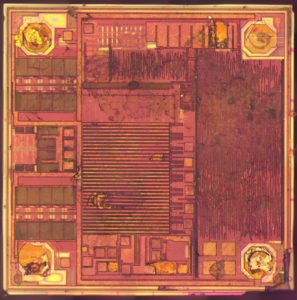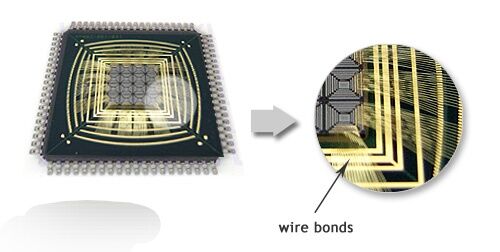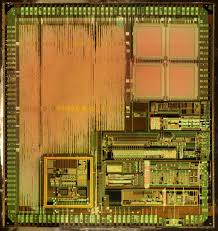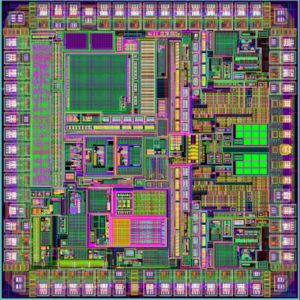Posts Tagged ‘break ic source eeprom’
 Break IC PIC16F917 Heximal
Break IC PIC16F917 Heximal
Break IC PIC16F917 and readout the Heximal from mcu pic16f917 which has been extracted from microcontroller pic16f917 embedded flash;

Break IC PIC16F917 and readout the Heximal from mcu pic16f917 which has been extracted from microcontroller pic16f917 embedded flash
The external Resistor-Capacitor (RC) modes support the use of an external RC circuit. This allows the designer maximum flexibility in frequency choice while keeping costs to a minimum when clock accuracy is not required. There are two modes: RC and RCIO.
In RC mode, the RC circuit connects to OSC1. OSC2/CLKOUT outputs the RC oscillator frequency divided by 4. This signal may be used to provide a clock for external circuitry, synchronization, calibration, test or other application requirements. Figure 4-5 shows the external RC mode connections after recover pic16f873 IC.
The INTOSC and INTOSCIO modes configure the internal oscillators as the system clock source when (SCS) bit of the OSCCON register. user-adjusted via software using the OSCTUNE register (Register 4-2).
2. The LFINTOSC (Low-Frequency Internal Oscillator) is uncalibrated and operates at 31 kHz. The system clock speed can be selected via software.
INTERNAL CLOCK MODEL
The Oscillator module has two independent, internal oscillators that can be configured or selected as the system clock source.
1. The HFINTOSC (High-Frequency Internal Oscillator) is factory calibrated and operates at 8 MHz. The frequency of the HFINTOSC can be user-adjusted via software using the OSCTUNE register (Register 4-2) for the purpose of recover microcontroller tms320f2812pgfa firmware.
2. The LFINTOSC (Low-Frequency Internal Oscillator) is uncalibrated and operates at 31 kHz. The system clock speed can be selected via software using the Internal Oscillator Frequency Select bits IRCF<2:0> of the OSCCON register. an>
The INTOSC and INTOSCIO modes configure the internal oscillators as the system clock source when bit of the OSCCON register. See Section 4.6 user-adjusted via software using the OSCTUNE register (Register 4-2).
2. The LFINTOSC (Low-Frequency Internal Oscillator) is uncalibrated and operates at 31 kHz. The system clock speed can be selected via software.
 Break IC ATtiny261 Code
Break IC ATtiny261 Code
Break IC ATtiny261 secured memory and extract mcu attiny261 Code from flash and eeprom memory, include program and data in the format of heximal, in the software extraction process from Microcontroller attiny261, the security fuse bit will be cracked;

High Performance, Low Power AVR® 8-Bit Microcontroller
Advanced RISC Architecture
– 123 Powerful Instructions – Most Single Clock Cycle Execution
– 32 x 8 General Purpose Working Registers
– Fully Static Operation
Non-volatile Program and Data Memories
– 2/4/8K Byte of In-System Programmable Program Memory Flash
(ATtiny261/461/861)
Endurance: 10,000 Write/Erase Cycles if recovr stm32f107rct6 IC
– 128/256/512 Bytes In-System Programmable EEPROM (ATtiny261/461/861)
Endurance: 100,000 Write/Erase Cycles
– 128/256/512 Bytes Internal SRAM (ATtiny261/461/861)
– Programming Lock for Self-Programming Flash Program and EEPROM Data Security
Peripheral Features
– 8/16-bit Timer/Counter with Prescaler and Two PWM Channels
– 8/10-bit High Speed Timer/Counter with Separate Prescaler
3 High Frequency PWM Outputs with Separate Output Compare Registers
Programmable Dead Time Generator
– Universal Serial Interface with Start Condition Detector when copy at89s8252 flash memory content
– 10-bit ADC
11 Single Ended Channels
16 Differential ADC Channel Pairs
15 Differential ADC Channel Pairs with Programmable Gain (1x, 8x, 20x, 32x)
– Programmable Watchdog Timer with Separate On-chip Oscillator
– On-chip Analog Comparator
Special Microcontroller Features
– debugWIRE On-chip Debug System
– In-System Programmable via SPI Port
– External and Internal Interrupt Sources
– Low Power Idle, ADC Noise Reduction, and Power-down Modes
– Enhanced Power-on Reset Circuit
– Programmable Brown-out Detection Circuit
– Internal Calibrated Oscillator
I/O and Packages
– 16 Programmable I/O Lines
– 20-pin PDIP, 20-pin SOIC and 32-pad MLF
Operating Voltage:
– 1.8 – 5.5V for ATtiny261V/461V/861V
– 2.7 – 5.5V for ATtiny261/461/861
Speed Grade:
– ATtiny261V/461V/861V: 0 – 4 MHz @ 1.8 – 5.5V, 0 – 10 MHz @ 2.7 – 5.5V
– ATtiny261/461/861: 0 – 10 MHz @ 2.7 – 5.5V, 0 – 20 MHz @ 4.5 – 5.5V
– Active Mode: 1 MHz, 1.8V: 380ìA
– Power-down Mode: 0.1ìA at 1.8V
Typical values contained in this data sheet are based on simulations and characterization of other AVR microcontrollers manufactured on the same process technology. Min and Max values will be available after the device is characterized before Break IC.
The ATtiny261/461/861 is a low-power CMOS 8-bit microcontroller based on the AVR enhanced RISC architecture. By executing powerful instructions in a single clock cycle, the ATtiny261/461/861 achieves throughputs approaching 1 MIPS per MHz allowing the system designer to optimize power consumption versus processing speed after Break IC.
 Break IC ATtiny2313 Code
Break IC ATtiny2313 Code
Break IC ATtiny2313 tamper resistance system, extract Code from chip attiny2313 memory after avr microcontroller attiny2313 flash memory has been broken;

High Performance, Low Power AVR® 8-Bit Microcontroller
Advanced RISC Architecture
– 120 Powerful Instructions – Most Single Clock Cycle Execution
– 32 x 8 General Purpose Working Registers
– Fully Static Operation
– Up to 20 MIPS Throughput at 20 MHz
Data and Non-volatile Program and Data Memories
– 2/4K Bytes of In-System Self Programmable Flash
Endurance 10,000 Write/Erase Cycles
– 128/256 Bytes In-System Programmable EEPROM
Endurance: 100,000 Write/Erase Cycles
– 128/256 Bytes Internal SRAM when Break IC
– Programming Lock for Flash Program and EEPROM Data Security
Peripheral Features
– One 8-bit Timer/Counter with Separate Prescaler and Compare Mode
– One 16-bit Timer/Counter with Separate Prescaler, Compare and Capture Modes
– Four PWM Channels
– On-chip Analog Comparator
– Programmable Watchdog Timer with On-chip Oscillator
– USI – Universal Serial Interface
– Full Duplex USART
Special Microcontroller Features
– debugWIRE On-chip Debugging
– In-System Programmable via SPI Port
– External and Internal Interrupt Sources
– Low-power Idle, Power-down, and Standby Modes
– Enhanced Power-on Reset Circuit if Break mcu atmega16pa flash
– Programmable Brown-out Detection Circuit
– Internal Calibrated Oscillator
I/O and Packages
– 18 Programmable I/O Lines
– 20-pin PDIP, 20-pin SOIC, 20-pad MLF/VQFN
Operating Voltage
– 1.8 – 5.5V
Speed Grades
– 0 – 4 MHz @ 1.8 – 5.5V
– 0 – 10 MHz @ 2.7 – 5.5V
– 0 – 20 MHz @ 4.5 – 5.5V
Industrial Temperature Range: -40°C to +85°C
Low Power Consumption
In-System
Programmable Flash
– Active Mode
190 µA at 1.8V and 1MHz
– Idle Mode
24 µA at 1.8V and 1MHz
– Power-down Mode
0.1 µA at 1.8V and +25°C
Port A is a 3-bit bi-directional I/O port with internal pull-up resistors (selected for each bit). The Port A output buffers have symmetrical drive characteristics with both high sink and source capability, except PA2 which has the RESET capability.
To use pin PA2 as I/O pin, instead of RESET pin, program (“0”) RSTDISBL fuse. As inputs, Port A pins that are externally pulled low will source current if the pull-up resistors are activated. The Port A pins are tri-stated when a reset condition becomes active, even if the clock is not running after Break IC.
 Break IC ATtiny85V Software
Break IC ATtiny85V Software
Break IC ATtiny85V can help engineer to readout the embedded firmware from mcu attiny85v flash and eeprom memory, fuse bit of microcontroller attiny85v can be cracked;

Break IC ATtiny85V can help engineer to readout the embedded firmware from mcu attiny85v flash and eeprom memory, fuse bit of microcontroller attiny85v can be cracked
XTAL1 and XTAL2 are the input and output, respectively, of an inverting amplifier which can be configured for use as an on-IC oscillator, as shown in Figure 1. Either a quartz crystal or ceramic resonator may be used. To drive the device from an external clock source, XTAL2 should be left unconnected while XTAL1 is driven as shown in Figure 2. There are no requirements on the duty cycle of the external clock signal, since the input to the internal clocking circuitry is through a divide-by-two flip-flop, but minimum and maximum voltage high and low time specifications must be observed.
In idle mode, the CPU puts itself to sleep while all the on-IC peripherals remain active. The mode is invoked by software. The content of the on-IC RAM and all the special functions registers remain unchanged during Break mcu pic16f876 memory.
Figure 2. External Clock Drive Configuration mode. The idle mode can be terminated by any enabled interrupt or by a hardware reset before Break IC. It should be noted that when idle is terminated by a hardware reset, the device normally resumes program execution, from where it left off, up to two machine cycles before the internal reset algorithm takes control. On-IC hardware inhibits access to internal RAM in this event, but access to the port pins is not inhibited.
To eliminate the possibility of an unexpected write to a port pin when Idle is terminated by reset, the instruction following the one that invokes Idle should not be one that writes to a port pin or to external memory. In the power down mode the oscillator is stopped, and the instruction that invokes power down is the last instruction executed. The on-IC RAM and Special Function Registers retain their values until the power down mode is terminated.
The only exit from power down is a hardware reset. Reset redefines the SFRs but does not change the on-IC RAM. The reset should not be activated before VCC is restored to its normal operating level and must be held active long enough to allow the oscillator to restart and stabilize if Break IC.